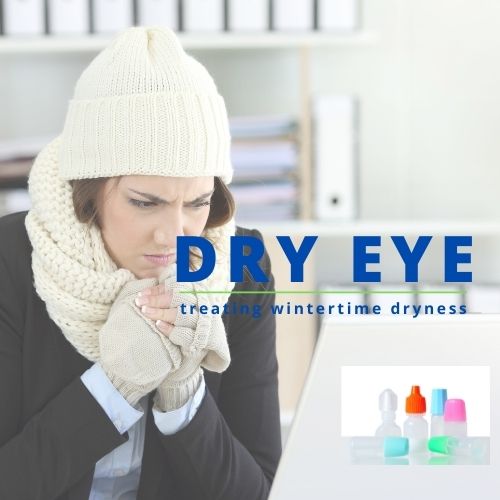Wintertime Dry Eye


Wintertime dry eye can be worse than other seasons of the year.
Dry indoor air and being outdoors on cold windy days can worsen wintertime dry eye symptoms. You can recognize dry eyes by the scratchy, itchy, and burning sensation in your eyes along with redness and blurry vision.
Blurred vision is one of the primary symptoms of dry eyes and that is because tear film is an important component of excellent vision. Approximately two-thirds of the refractive power of the eye comes from the air-tear film interface and the cornea. Refractive power refers to the eyes ability to focus light onto the retina.
Tear film has three layers. A lipid layer, which is an oily layer, that prevents tear evaporation, then an aqueous layer, that supplies the moisture for your eyes, and lastly, the mucin layer which allows the aqueous layer to spread evenly over the surface of the eye.
Wintertime Dry Eye Prevention
You can do the following to help reduce the symptoms of winter dry eyes:
- Increase the humidity in the air by using a humidifier.
- Turn the heat in your home down a little
- Wear sunglasses outdoors. The wraparound style provides the best protection from drying winter winds.
- Avoid becoming dehydrated by drinking plenty of water.
- Remember to blink regularly when reading or staring at a computer for long periods to refresh your tear film.
- Adding tears. Mild cases of dry eyes can be managed using over-the-counter artificial tears. You can use artificial tears as often as needed to supplement your natural tears. Preservative-free artificial tears are recommended because the preservatives can irritate the eyes.
Treatment
Treating the eyelid or ocular surface: If the preventative steps along with over-the-counter artificial tears don’t manage your symptoms, your eye doctor may prescribe prescription eye drops or ointments, along with using warm compresses and lids massages, and eyelid cleaners to help decrease inflammation around the surface of your eyes and unblock the Meibomian glands in your eyes that are not secreting enough oil for the lipid layer of your tears. Meibomian gland blockages cause your tears to evaporate too quickly.
Cyclosporine eye drops: These prescription eye drops are an immunosuppressant and can treat a type of dry eye caused by inflammation.
Punctal plugs: These are tiny devices about the size of a grain of rice that stop the fluid from draining from the eye. They can be temporary and made of collagen that gradually breads down and is absorbed by the body. This type is used when you want to try out punctal plugs to see if they work for you. If they do then semi-permanent plugs made of medical plastic will be inserted.
Diagnosis
The cause of your dry eyes can be diagnosed with a comprehensive eye examination with an emphasis on the evaluation of the quantity and quality of the tear film your eyes produce and examining your Meibomian glands for blockages.
If you would like to make an appointment, call us 609.877.2800 or EMail us.
Gregory Scimeca, M.D.
Ophthalmologist and Medical Director
The Eye Professionals
Our Locations
